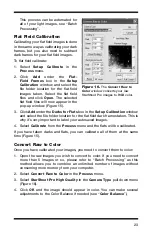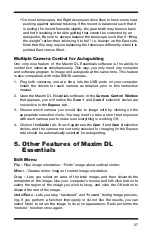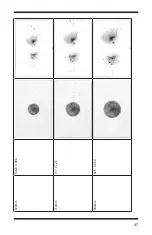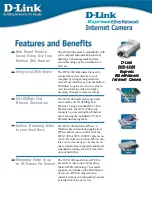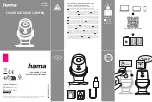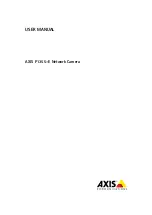
36
telescope does not move, check the
Settings
. Remember, you have to set
up a method for sending the autoguider commands to the telescope!
11. The star should move in an L shape. If it does not move enough, a warning
message will appear. The recorded positions will be displayed in the scroll-
ing log, along with any error messages.
Note: If the star does not move far enough, or moves too far (i.e. the star leaves
the field), the duration of the calibration move commands can be adjusted by
clicking the
Settings
command and changing the
Calibration Time
fields
(measured in seconds). A longer calibration time will increase the motion of the
star; a shorter time will decrease the motion. Typical values range from five to
ten seconds, depending on the correction speed, focal length, and pixel size.
12. Once you have successfully calibrated, switch to the
Track
mode. Click
Start
, and watch the star. It should move to the center of the small track
box, and whenever it drifts off it should be pulled back again. You can
zoom in the window for a better look. Also the tracking errors will be dis-
played in the scrolling log.
13. If the star bounces back and forth, reduce the aggressiveness for that
axis. If it corrects too slowly, increase the aggressiveness. Changes to the
aggressiveness settings take effect immediately.
You are now ready to take a long-exposure image through the main telescope
and imaging camera. The StarShoot Pro will continuously send small correc-
tion factors to the mount’s motor drive to insure steady and accurate tracking
throughout the duration of the exposure, however long that may be.
Other Autoguiding Notes:
• If you are using a German equatorial mount you must calibrate with the
tube on the same side of the mount as it will be when actually imaging.
• The calibration settings need changing if you move the telescope in
declination by more than about five degrees. Select another bright star,
and Calibrate again.
• If you experience bad guiding in declination and cannot resolve it
through adjusting the calibration or aggressiveness, you may have a
stiction problem with your declination drive. Watch which way the star
drifts, and turn off the Guider Enable checkbox (in the Settings window)
that pushes the star in that direction. That will prevent the stiction cycle
from happening.
• Make sure that any backlash compensation in the mount is turned off.


